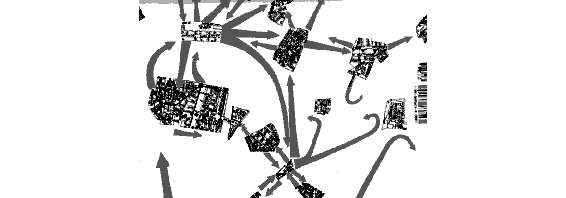![hypertext city]()
As a conceptual framework, Hypertext provides a specific means of configuring issues sourrounding the confrontation of cyberspace and the city. It does so by embracing the advent of the electronic realm and the proliferation of networked links while at the same time interpreting these technological transformations as part of the project of writing. More specifically, studies of hypertext have focussed on the history of writing as technology, on the potential for hypertext to change the relationships between reading and writing, to alter the demarcations between the inside and outside of the text, and to change the nature and role of narrative. For its proponents, hypertext is the mode of writing that articulates the sociality of the network, that promises democratization and the empowerment of the individual, and that rearticulates themes that writing and the city have been seen to share: in the construction of memory, in the relation between movement and the subject, and in the production of space through abstraction and narrative.
Read More
![hypertext]()
In the July, 1945 issue of The Atlantic Monthly, Vannevar Bush, who had served as the first director of the Office of Scientific Research and Development, the agency established by Roosevelt to coordinate federally funded defense research, published an article entitled "As We May Think." In it, he pointed out the increasing gap between the growing mountain of research and the inadequacies of methods for transmitting and reviewing its results, which he blamed in part on the artificiality of systems of indexing. He suggested that the human mind operates by association. "With one item in its grasp, it snaps instantly to the next that is suggested by the association of thoughts, in accordance with some intricate web of trails carried by the cells of the brain." He proposed "a mechanized, enlarged, and intimate supplement to an individual's memory, a future device" which he called a "memex" using electro-mechanical technology as a device for associative indexing, a reading and writing machine that would allow "wholly new forms of encyclopedias to appear, with a mesh of mesh of associative trails running through them." Users would create "endless trails" of links...exactly as if the physical items had been gathered together from widely separated sources and bound together to form a new book."
Read MoreThe textual space of the printed page has come to be seen as arbitrary and self-contained. The arbitrariness is a result of the alphabet, referring to sounds in an arbitrary (and contextual) way, to the concept of the linguistic sign, which after Saussure, was described primarily as an arbitrary link between signifier and signified, and to the culture of the printed book, which has striven towards legibility through typographic simplicity and the exlusion of pictorial attributes to the page itself.
But at different moments in the history of writing, the surface has been endowed with pictorial qualities. Picture writing, which is generally thought of as the historical precursor of phonetic writing, refers through stylized images. The bridge from picture writing to phonetic writing was the realization that picture elements could be identified with sounds in language. Through the process of phonetization and abstraction, writing becomes a secondary system depending on spoken language for its meaning. (much of Derrida's work is a criticism of this idea...presumably because the system which is supposed to be secondary has become so important.) see writing.
An example of orchestrated simultaneity on the page is Blaise Cendrars' and Sonia Delaunay’s La Prose du Transsibérien et de la petite Jehanne de France , which combined poems, maps, and illustrations on a sheet two meters long.
Read MoreThe idea of quoting without copying was called transclusion by the designers of Ted Nelson's Xanadu operating system. The most innovative commercial feature of the hypertext system was a royalty and copyright scheme for use without copying. Whenever an author wished to quote, he or she would use transclusion to " virtually include" a passage by pointing to the original. (This function operates like the "make alias" command on the macintosh. It is a pointer rather than a copy.) Literal copying would be forbidden in the Xanadu system. A fee could be charged for transclusion, every time an individual work was being read or quoted.
Read More
